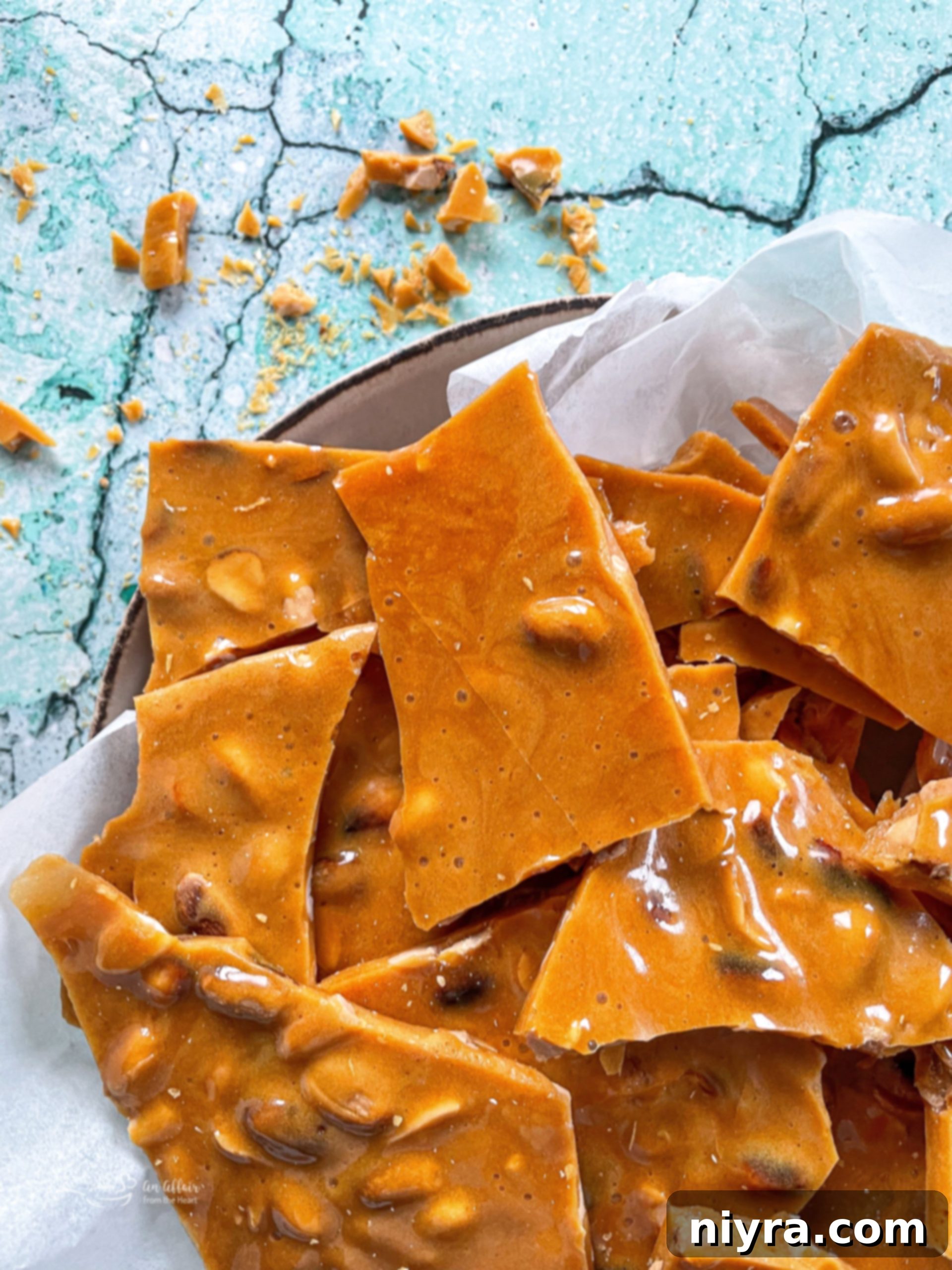Crafting the Perfect Peanut Brittle: A Timeless Homemade Treat
Peanut brittle is a beloved hard candy enjoyed in countless countries, each with its own unique regional twist. At its heart, it’s a simple yet magical confection: nuts, most commonly peanuts, encased in sugar cooked to a state of delightful crunchiness and glass-like fragility. For those with peanut allergies, fear not! This versatile recipe graciously welcomes other types of nuts, allowing everyone to savor this classic treat.
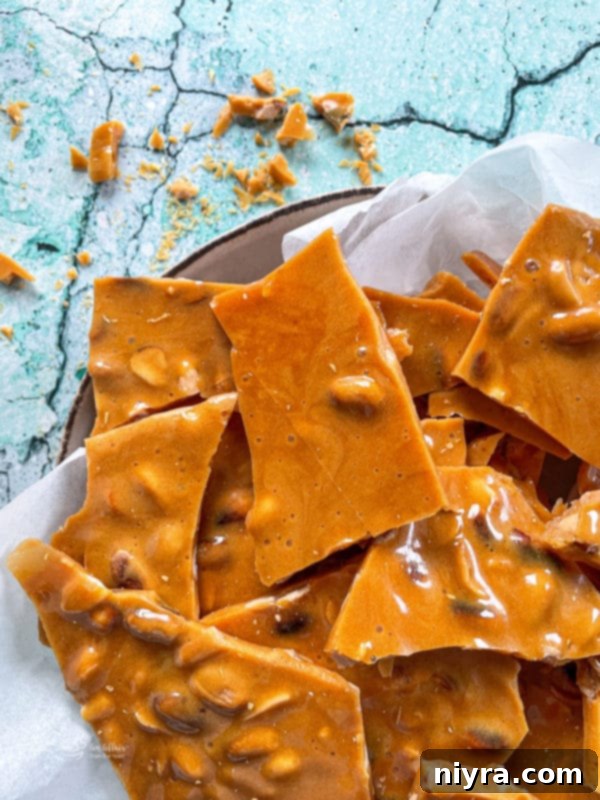
If you had told me years ago that I would be sharing a recipe for peanut brittle, I might have thought you were, well, *nuts*! (And I couldn’t resist that pun.) For a long time, I was under the impression that making peanut brittle was an incredibly difficult endeavor, a culinary challenge reserved for experienced confectioners. This misconception kept me from attempting it myself, despite my love for its buttery, nutty, and irresistibly crunchy appeal.
However, I’m here to tell you a game-changing secret: the single most important tool you need for truly great peanut brittle is a reliable candy thermometer. This humble gadget transforms a seemingly daunting task into a surprisingly straightforward and rewarding experience, ensuring perfect results every time.
What Exactly Is Peanut Brittle? A Dive Into This Crunchy Confection
Peanut brittle is a classic candy confection known for its signature crisp, hard texture that shatters wonderfully with each bite. Essentially, it’s a type of hard candy made by cooking sugar with water or corn syrup to a very high temperature, then adding nuts, butter, baking soda, and vanilla. The high temperature causes the sugar to reach what’s known as the “hard crack stage,” where it becomes extremely rigid and brittle upon cooling. The addition of baking soda is crucial; it reacts with the hot sugar to create tiny air bubbles, which contribute to the brittle’s light, airy, and easily breakable texture. Without it, your candy would be more like hard, dense glass.
My particular recipe incorporates both dark and light corn syrup alongside sugar. This blend isn’t just for flavor; it plays a vital role in achieving that perfect, consistent crunch and helps prevent sugar crystallization, which can lead to grainy brittle. The corn syrups also enhance the caramelization process, deepening the rich, toasted notes that make homemade peanut brittle so incredibly delicious. A truly good peanut brittle should literally shatter into delightful pieces once it cools—otherwise, as the name suggests, it wouldn’t be “brittle” at all, right?
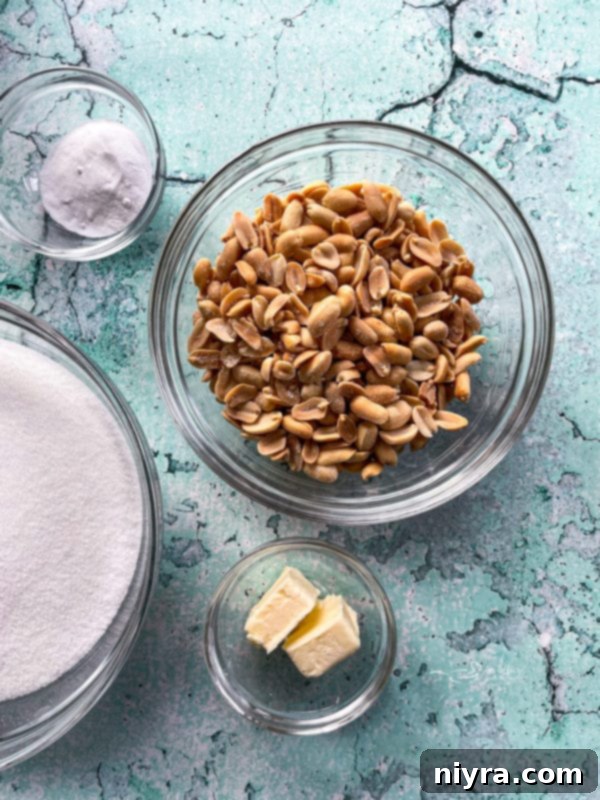
Essential Ingredients for Irresistible Peanut Brittle
Creating this classic candy requires just a handful of straightforward ingredients. Each plays a crucial role in achieving the perfect balance of sweetness, crunch, and rich flavor. Here’s what you’ll need:
- **Sugar:** The foundation of any candy, providing the essential sweetness and structure.
- **Water:** Helps dissolve the sugar initially and allows the mixture to reach the desired temperature.
- **Light Corn Syrup:** A key ingredient for preventing sugar crystallization, ensuring a smooth, clear, and perfectly brittle texture.
- **Dark Corn Syrup:** Adds a deeper, richer caramel flavor and a beautiful golden-brown hue to the brittle.
- **Peanuts:** The star of the show! Salted Spanish peanuts are often preferred for their small size and robust flavor, which perfectly complements the sweet candy.
- **Butter:** Contributes to the brittle’s rich flavor and helps in its spreadability.
- **Baking Soda:** The secret ingredient for achieving that classic brittle texture. It reacts with the hot sugar to create tiny air pockets, making the candy light and easy to shatter.
- **Vanilla Extract:** Adds a warm, aromatic depth that beautifully rounds out the overall flavor profile.
You’ll find the exact measurements and detailed quantities in the comprehensive printable recipe card located further down this page.
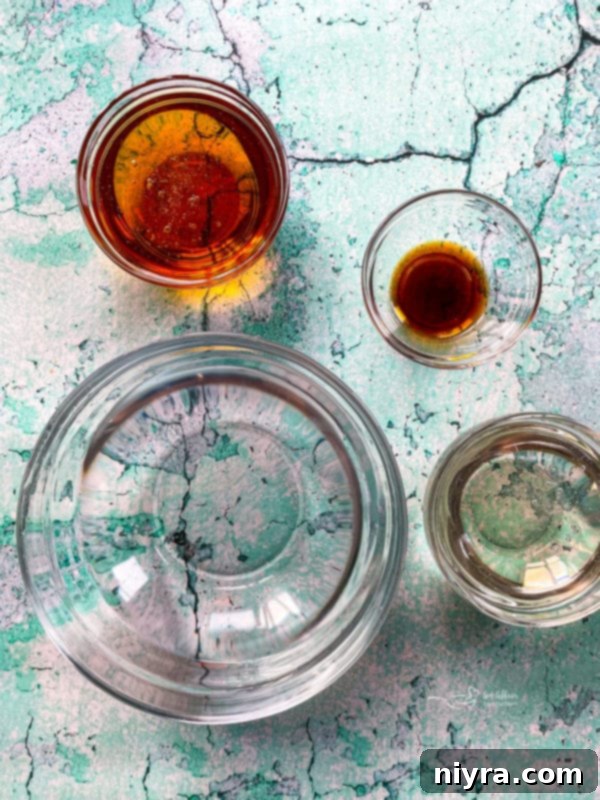
The Art of Crafting Homemade Peanut Brittle: A Step-by-Step Guide
Making peanut brittle might seem intimidating, but with careful attention to temperature and a bit of organization, it’s a truly rewarding process. Here’s a detailed guide to help you achieve perfect, shatteringly crisp brittle every time.
1. Prepare Your Workspace and Ingredients
Before you even turn on the stove, ensure everything is ready to go. Candy making moves quickly, and you won’t have time to scramble for tools or ingredients once the cooking process begins. Line at least two, preferably three, large baking sheets with parchment paper. This non-stick surface is crucial for easily removing the brittle once it cools. Have all your ingredients measured out and within arm’s reach. This preparation, often called “mise en place,” is a fundamental step for success in confectionary.
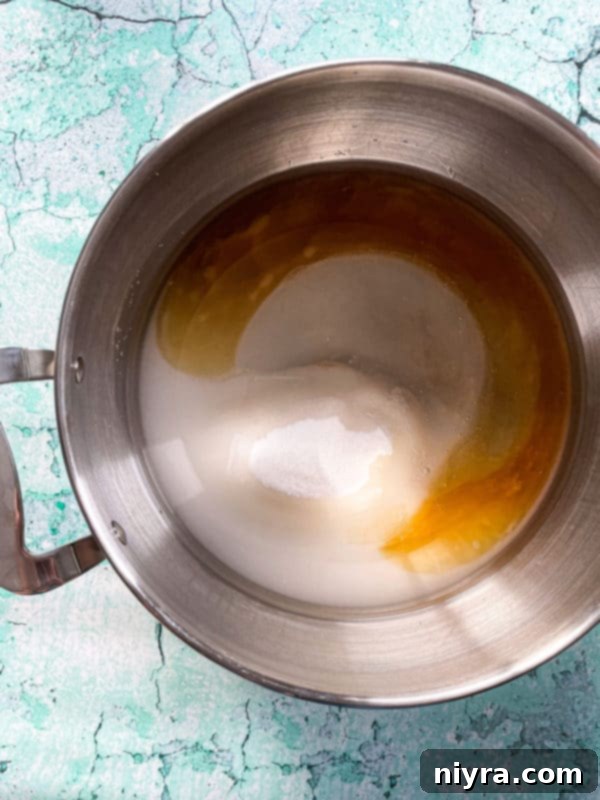
2. Begin the Sugar Syrup Foundation
In a large, heavy-bottomed saucepan—essential for even heat distribution and preventing scorching—combine the sugar, water, light corn syrup, and dark corn syrup. Place the pan over medium heat. Stir the mixture occasionally at this initial stage, just until the sugar is completely dissolved. Once the sugar has fully dissolved and the mixture reaches a rolling boil, stop stirring. Insert your candy thermometer, making sure the bulb doesn’t touch the bottom of the pan.
3. Cooking to the Hard Ball Stage
Continue boiling the syrup without stirring over medium heat. This is where your candy thermometer becomes indispensable. Allow the mixture to cook until it reaches 260°F (127°C). This temperature corresponds to the “hard ball stage,” a crucial step in the candy-making process. At this point, a drop of the syrup into cold water would form a firm, yet pliable, ball.
4. Incorporate Peanuts and Butter
Once the syrup reaches 260°F, it’s time to add the salted peanuts and butter. Stir these ingredients into the hot syrup. Continue cooking, stirring frequently to prevent sticking and ensure even cooking, until the mixture reaches the “hard crack stage,” which is 300°F (149°C). This stage is critical for the brittle’s final texture. When dropped into cold water, the syrup should immediately form hard, brittle threads that snap easily. The mixture will also start to take on a beautiful golden-amber color as the sugars caramelize, intensifying in flavor.
5. The Foaming Transformation: Baking Soda and Vanilla
Immediately remove the pan from the heat once it hits 300°F. Swiftly stir in the baking soda and vanilla extract. You’ll notice a remarkable transformation: the mixture will vigorously foam up and expand. This reaction is exactly what you want! The baking soda releases carbon dioxide bubbles, creating the porous structure that gives peanut brittle its characteristic light, airy, and shatteringly crisp texture. Work quickly during this step, as the candy will begin to set.
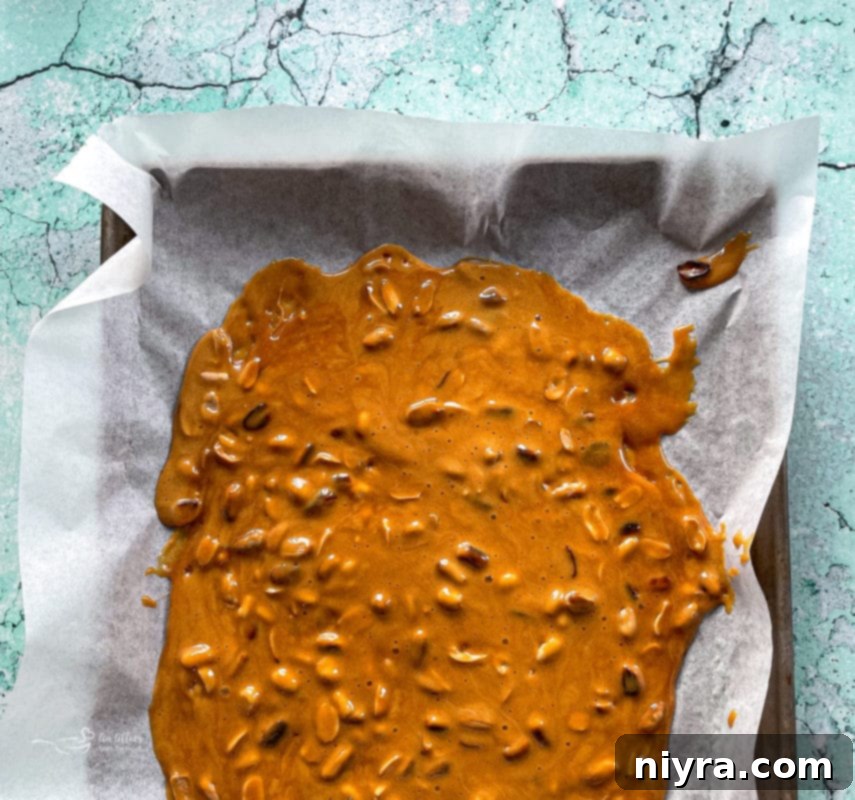
6. Spreading and Cooling
Without delay, pour the hot, foamy mixture onto your prepared parchment-lined baking sheets. Using a heat-resistant spatula or the back of a lightly buttered spoon, spread the brittle out as thinly and evenly as possible. The thinner you spread it, the crispier your brittle will be. Work quickly, as the candy sets very fast. Allow the brittle to cool completely and undisturbed at room temperature. This can take anywhere from 30 minutes to an hour, or even longer depending on your kitchen’s humidity.
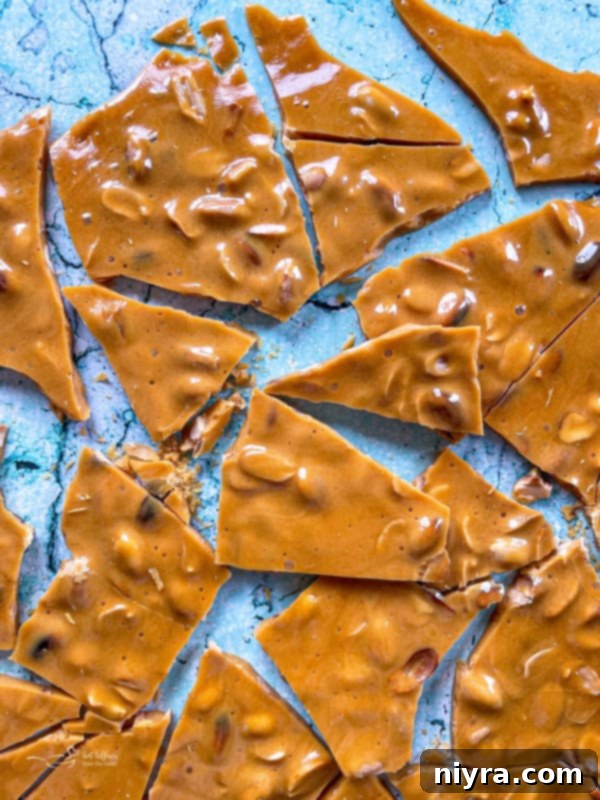
7. Break and Enjoy!
Once completely cooled and hardened, your peanut brittle is ready to be broken into pieces. Don’t worry about getting uniform sizes; part of the charm of homemade brittle is its wonderfully irregular shapes and sizes. You can simply use your hands to snap it, or for larger sheets, the handle of a sturdy knife or any other kitchen utensil can assist in breaking it into smaller, manageable, and delicious shards.

The satisfying crack and the sweet, nutty aroma of freshly made brittle are truly unparalleled. Enjoy your homemade masterpiece!
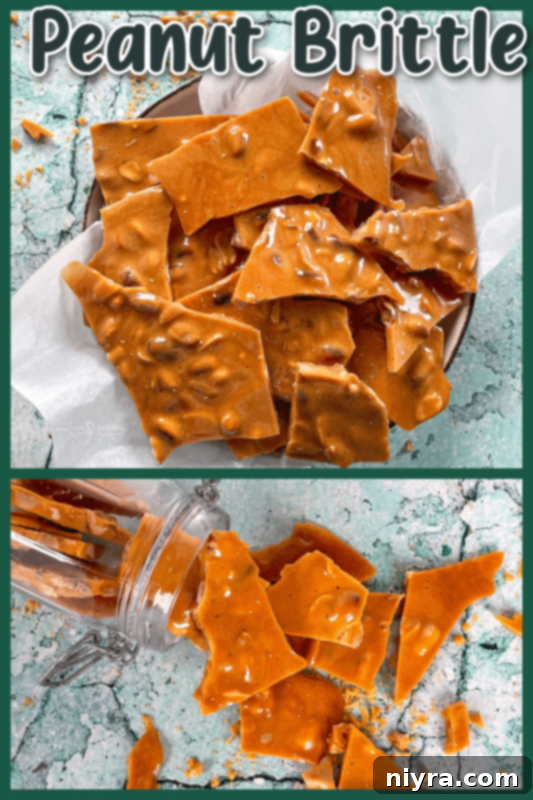
Love This Recipe? Pin It for Later!
If you’re excited to try your hand at this old-fashioned peanut brittle, make sure you can easily find the recipe when you’re ready to bake! Pin it to your favorite Pinterest recipe board now, so it’s always just a click away.

Important Safety Note: Handling Hot Candy Brittle
When working with hot sugar syrup, extreme caution is paramount. This mixture reaches incredibly high temperatures, comparable to molten lava, and can cause severe burns if it comes into contact with your skin. Always exercise the utmost care during the entire cooking and pouring process. Ensure your baking sheets are placed on a stable, heat-proof surface before pouring, and always use parchment paper to prevent sticking. Pour the hot brittle evenly across the sheets to facilitate even cooling. Most importantly, resist the urge to touch or taste the candy until it has completely cooled and solidified. Patience is key for both safety and perfect texture.

The Role of Dark and Light Corn Syrup in Peanut Brittle
While some traditional brittle recipes rely solely on sugar and water, I find that incorporating both dark and light corn syrup simplifies the process and delivers more consistent, superior results. Using corn syrup helps prevent sugar crystallization, which can make your brittle grainy instead of smooth and glassy. It ensures a more reliable “hard crack” texture every time.
You might wonder about the difference between light and dark corn syrups – it’s a great question! Light corn syrup, like the popular Karo syrup, offers a mild sweetness and helps control sugar crystal formation without adding significant flavor. Dark corn syrup, on the other hand, is made from refiner’s syrup, which is similar to molasses. This gives it a richer, more robust flavor profile and a darker hue, adding a wonderful depth of caramel notes to your peanut brittle that pure sugar simply can’t achieve on its own.
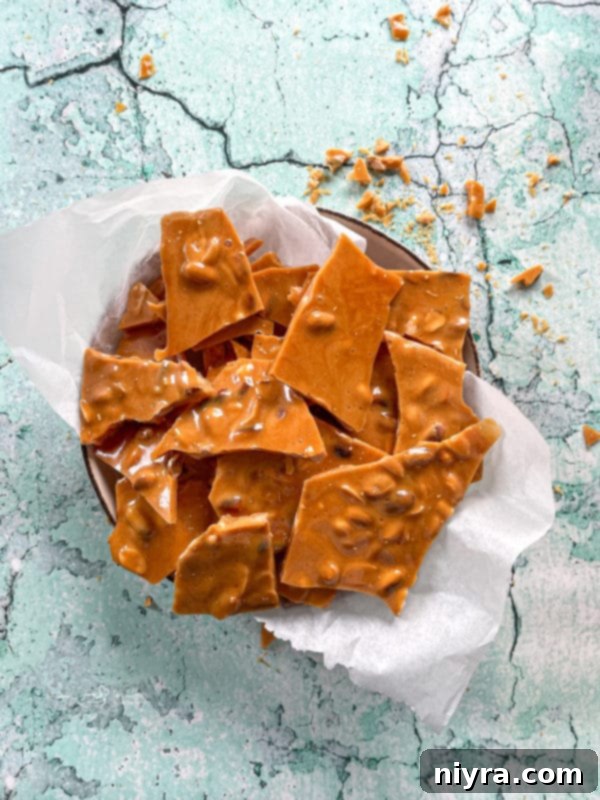
Troubleshooting: Why Is My Peanut Brittle Not Brittle?
Achieving that perfect, crisp snap is the ultimate goal for peanut brittle, but sometimes things don’t go as planned. If your brittle turns out chewy or sticky rather than shatteringly hard, there are usually two main culprits:
- **Incorrect Temperature (Under-cooked):** This is the most common reason. If the candy mixture doesn’t reach the full 300°F (hard crack stage), the sugar hasn’t cooked enough to achieve its brittle state. It will remain soft and pliable once cooled.
- **Forgetting the Baking Soda:** Baking soda is essential for creating the tiny air bubbles that give brittle its light, porous, and easily breakable texture. If you omit it, or if it’s old and inactive, your candy will be dense and hard, more like a sugar glass, but won’t “shatter” in the characteristic brittle way.
On the flip side, overcooking the mixture can lead to burnt flavors and a very dark, unappealing brittle. This is why a candy thermometer is truly your best friend. Trust its readings, but also pay attention to visual cues. As the sugar approaches the hard crack stage, it will deepen in color to a rich, golden amber. This caramelization indicates you’re very close, but the thermometer provides the precision needed to avoid guessing games and ensure flawless results.
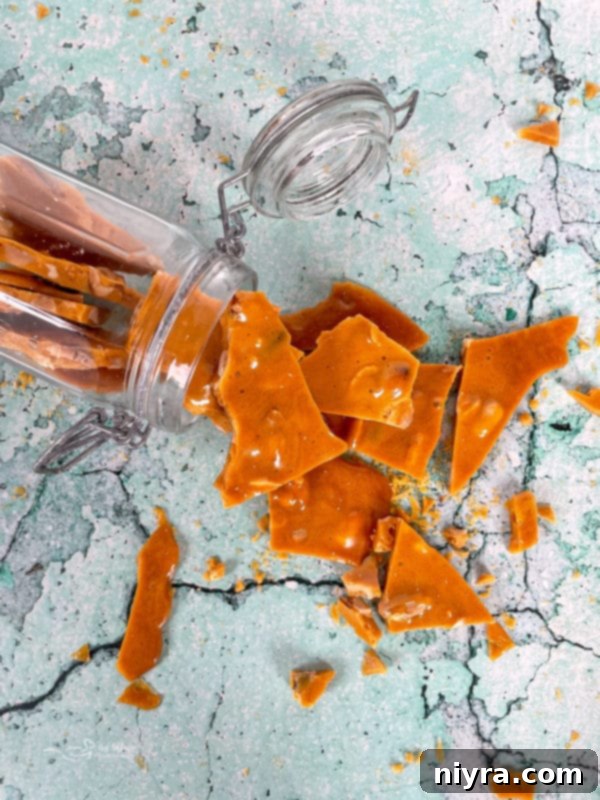
Can You Make Peanut Brittle Without a Thermometer? (Proceed with Caution!)
While it is technically *possible* to make peanut brittle without a candy thermometer, I strongly advise against it for consistent results. A thermometer removes all the guesswork and significantly reduces the risk of under-cooking or, worse, burning your candy. However, if you find yourself without one and are determined to try, there is a traditional “cold water test” method you can use:
Keep a small bowl of ice-cold water next to your stove. As your sugar mixture starts to deepen in color and approaches a caramel hue, carefully drip a small amount of the hot candy syrup into the cold water. Observe its behavior:
- If it dissolves or forms a soft, sticky ball, it’s not ready.
- If it forms a firm but still pliable ball (like taffy), you’re at the hard ball stage (around 250-265°F).
- If it immediately hardens into crisp, brittle threads that snap easily when bent, you’ve reached the hard crack stage (around 300°F).
Once it reaches the hard crack stage in the water, quickly remove the pan from the heat and proceed with adding the baking soda and vanilla. Just remember, this method relies heavily on visual cues and quick action, making it much easier to overcook or undercook the brittle. You’re definitely taking a risk by “winging” it, so proceed with extreme caution and keep a watchful eye!

Homemade Peanut Brittle: The Perfect Gift!
There’s something incredibly special about a homemade gift, and peanut brittle truly shines in this regard. Its delicious crunch and nostalgic charm make it a perfect present for almost any occasion. Package some of your freshly made brittle into beautiful gifts for teachers, thoughtful treats for co-workers, or a delightful hostess gift. Simply tie a festive ribbon around a glass jar filled with brittle shards, arrange pieces on a holiday cookie plate, or tuck them inside a cute decorative tin. It’s a gift that speaks volumes of care and effort, and one that is always warmly received.
Explore More Delicious Candy Recipes
If you enjoyed making this peanut brittle, you’ll love exploring other homemade candy creations. Here are some more delightful recipes to satisfy your sweet tooth and impress your friends and family:
- Graham Cracker Toffee
- Candy Cane Puppy Chow
- Cinnamon Rock Candy
- Salted Nut Roll With Candy Corns
- 30+ Holiday Candy Recipes (pictured above)
- White Chocolate Cream Cheese Fudge
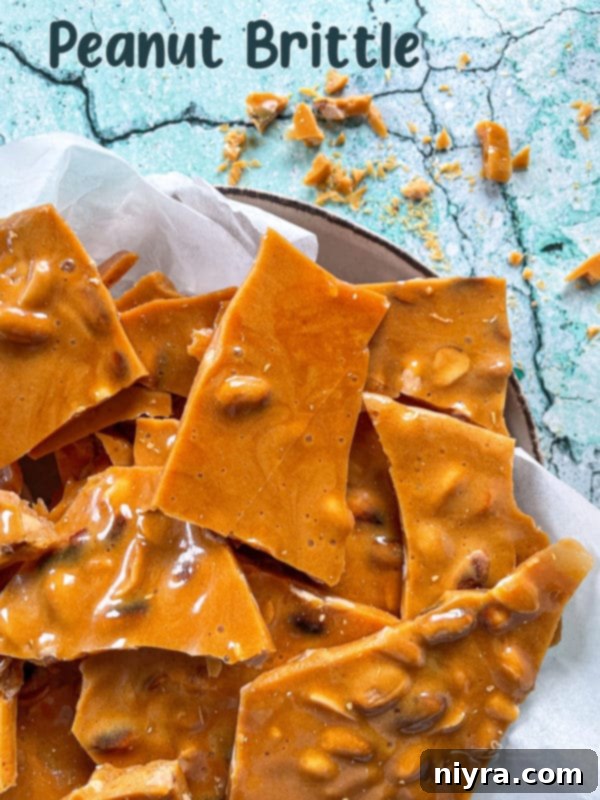
Now that you’re armed with all the knowledge, let’s make some truly amazing peanut brittle!

LIKE THIS RECIPE?
Don’t forget to give it a ⭐️⭐️⭐️⭐️⭐️ star rating and
leave a comment below the recipe!
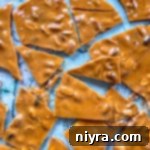
Print Recipe
Peanut Brittle
Equipment
- Reynolds Kitchens Non-Stick Parchment Paper
- 13×18 Half Sheet Pan
- Cuisinart Chef’s Classic Nonstick 1-Quart Saucepan with Lid
Ingredients
- 3 cups sugar
- 2 cups water
- 3/4 cup light corn syrup
- 3/4 cup dark corn syrup
- 2 cups salted Spanish peanuts
- 2 Tablespoons butter
- 1 Tablespoon baking soda
- 1 teaspoon vanilla extract
Instructions
- Line 3 large baking sheets with parchment paper.
- In a large heavy-duty pan, combine sugar, water, and corn syrups. Bring to a boil stirring occasionally to dissolve sugar. When mixture reaches a full boil, continue boiling without stirring over medium heat until the candy thermometer reaches 260 degrees or the “hardball stage.” Stir in the peanuts and the butter, stirring frequently until the mixture reaches the “hard crack stage” or 300 degrees.
- Remove from heat, stir in the baking soda and the vanilla, the mixture will become foamy. Pour onto lined baking sheets and spread out as thin as possible.
- Cool completely and break into pieces.
- Store in an airtight container.
Notes
Nutrition
This recipe was originally posted on December 17, 2012. It has been updated to improve user experience and re-shared on December 14, 2021.
Original recipe found at Taste of Home.
